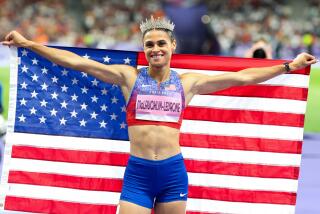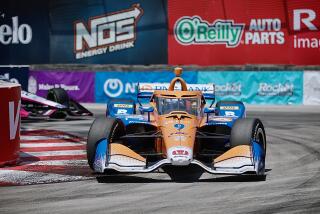MOTOR RACING U.S. INTERNATIONAL GRAND PRIX : Veteran Lawson Starts Over With New Cycle
- Share via
MONTEREY, Calif. — Eddie Lawson has won four world motorcycle road racing championships--more than any other rider in the last two decades--but this season the veteran from Upland may be facing his biggest challenge.
Lawson, after winning world titles for Yamaha and Honda, the two Japanese manufacturers who have dominated 500cc racing in recent years, has switched to Cagiva, an Italian cycle that is the only non-Japanese mount in the world championship series. In 10 years, Cagiva has not only never challenged for a championship, it has never won a race.
In moving to Cagiva, Lawson left Kenny Roberts’ Yamaha team that produced the world 500cc champion in Wayne Rainey of Downey and the world 250cc winner in John Kocinski of Little Rock, Ark. Lawson had another year on his contract with Roberts but still made the unusual move.
“It was one of those deals where it worked out well for everyone,” Lawson said. “Cagiva had announced it was going to quit racing unless it come up with something new, and I knew Kenny (Roberts) wanted to bring Kocinski up from the 250 bike to ride a 500. And I also knew he didn’t want to run three riders in the same class, so my moving made sense for all of us.”
If reports in European cycle publications are correct, it will be a profitable move for Lawson, 31, who is reported to be getting between $6 and $7 million for a two-year contract.
Lawson will be on the Cagiva today when round three of the world 500cc season, the United States International Grand Prix, is held on Laguna Seca’s tricky 2.196-mile hillside course. He won the inaugural race there in 1988 on a Yamaha. Rainey, who won his first world title last year, has won the past two U.S. races here.
Rainey was fast qualifier after a lap at 91.432 m.p.h. Saturday following a back-and-forth duel with teammate Kocinski, who ended up a tick behind at 91.361.
“Qualifying isn’t as important as it is for an auto race on a road course because we start four bikes on the front row and three in the gaps right behind them, so it’s a drag race to the first corner,” said Roberts, the California rider who has been the standard by which racers have been judged since he left Modesto in 1978 to win the world championship in his first try.
Lawson, who joined Roberts last year after winning a world title for Honda, had the most disappointing season of his career in 1990, caused by a high-speed crash during practice at Laguna Seca.
“I was coming over the crest of the hill after the first turn at full speed when I tried to brake down for the (90-degree) second turn and there were no brakes,” Lawson said. “The brake pad had fallen out and there was nothing there. I was going 150 m.p.h. when I should have been going about 50 and went straight into the haybales.
“Luckily, I hit feet first. The impact exploded my right heel. If I’d gone in head first, it would have been my head. The doctors said it was like jumping off a three-story building and landing on my feet.”
The crash shattered the heel into five large and 15 smaller pieces. It was pieced together in a four-hour operation in which doctors used a bone graft from Lawson’s hip and five screws that will remain in the heel.
“It was just mush for months, but it feels fine now,” Lawson said. “I don’t even limp and it doesn’t hurt, but I missed seven Grand Prix rehabilitating. It was the first time since I went to Europe in 1983 that I had missed a race, and the first time I wasn’t racing for the championship. It wasn’t a good feeling knowing I was struggling to finish in the top 10 instead of trying to win my fifth championship.”
Lawson, after missing seven races, was good enough in the final nine to finish seventh in points.
He was sixth in both of the first two races this season. Kevin Schwantz won on a Suzuki in Japan and Rainey won two weeks ago in Australia.
“There are five factory bikes with five outstanding riders--Rainey and Kocinski on Roberts’ Yamahas, Schwantz on the Suzuki and the two Australians, Wayne Gardner and Mike Doohan, on the Rothmans-Hondas.” Rainey leads Doohan by a point, 35-34, with Schwantz next with 31.
“If we can beat a couple of those guys, we’ll leave Laguna Seca with a good feeling,” Lawson said.
Roberts and Rainey believe he can do it.
“I wouldn’t be surprised if he ran third here,” Roberts said.
Rainey didn’t predict an outcome here but said, “I expect Eddie to win a couple of races this year, maybe later in the year after he’s had more time to sort out the new bike.”
Surviving 35 laps around Laguna Seca and its 11 turns will be the major consideration for most riders today. There are several blind corners where a rider must commit himself before he can see where he is going, which can be scary on a 160-horsepower two-wheeler capable of close to 200 m.p.h.
Laguna Seca is one of the slowest circuits among the 15 on the world schedule, but it is far from the easiest to ride.
“The Europeans badmouth Laguna Seca because they hate the corkscrew,” Roberts said of the distinctive switchback that drops riders from the top of the hill down a steep, swerving incline. Before entering the corkscrew, the bikes are flying up the hill in fifth gear, pulling between 11,000 and 12.000 revolutions per minute.
Rainey explains why: “The bike wants to wheelie going up the hill, but you have to get the front end down to brake and downshift to second gear for the corkscrew. For a second, just before you dip down, all you can see is sky and you’ve got to go on instinct. Before you can catch your breath, you’re plunging down to the left the way you’d go off a diving board.”
More to Read
Go beyond the scoreboard
Get the latest on L.A.'s teams in the daily Sports Report newsletter.
You may occasionally receive promotional content from the Los Angeles Times.










